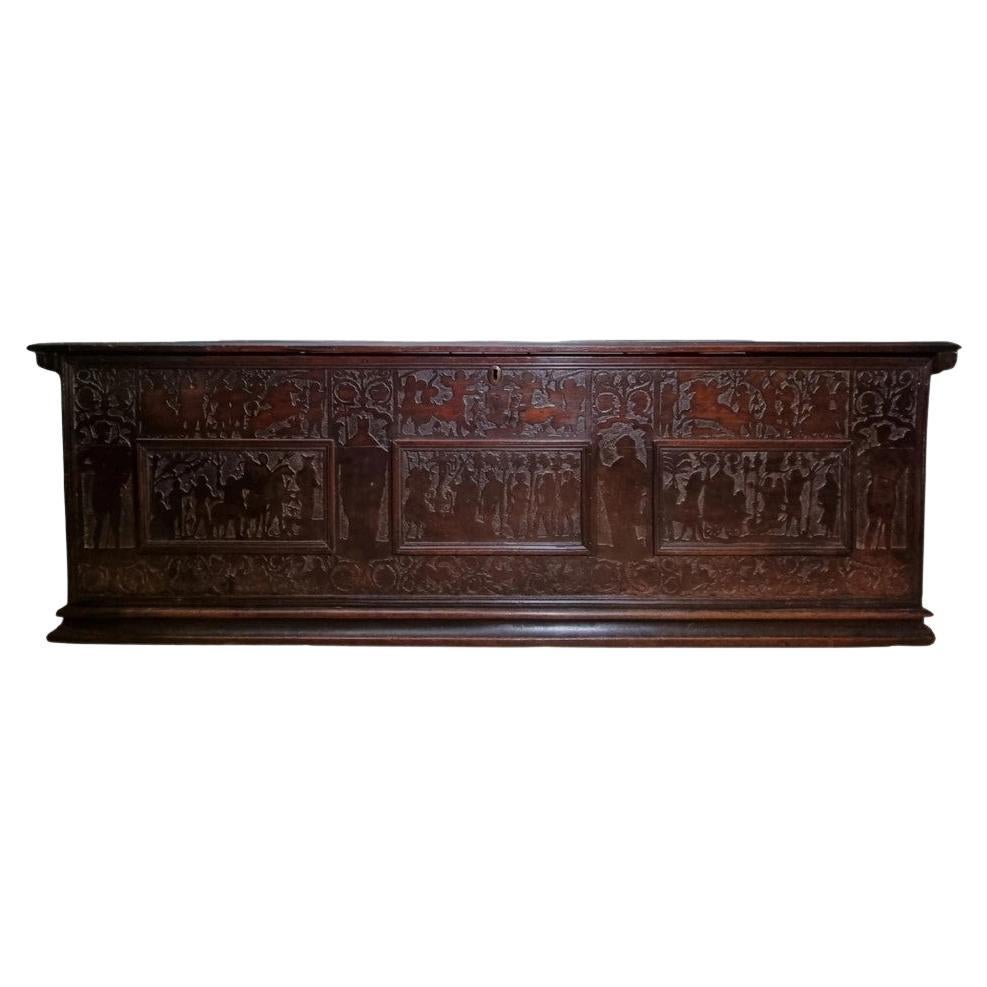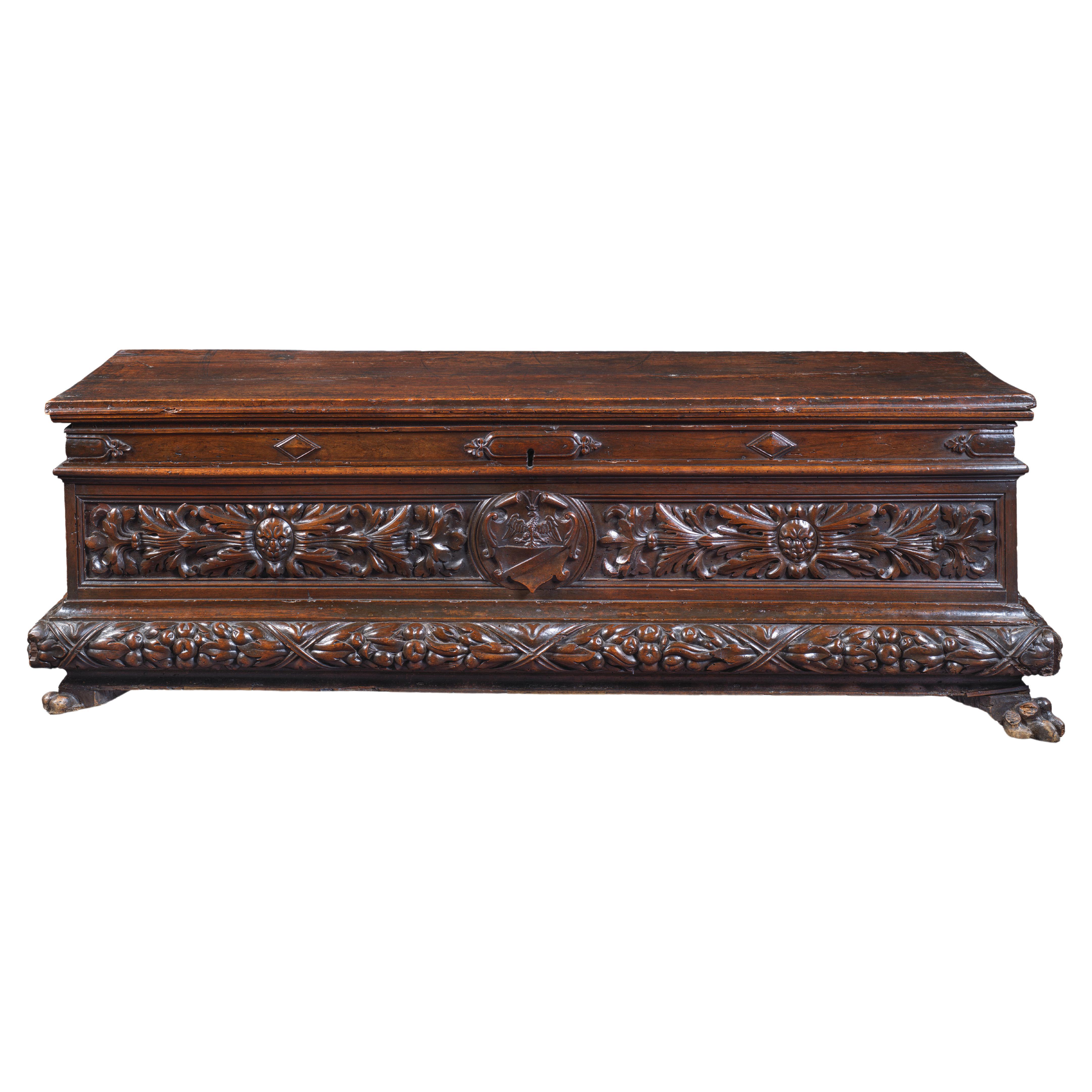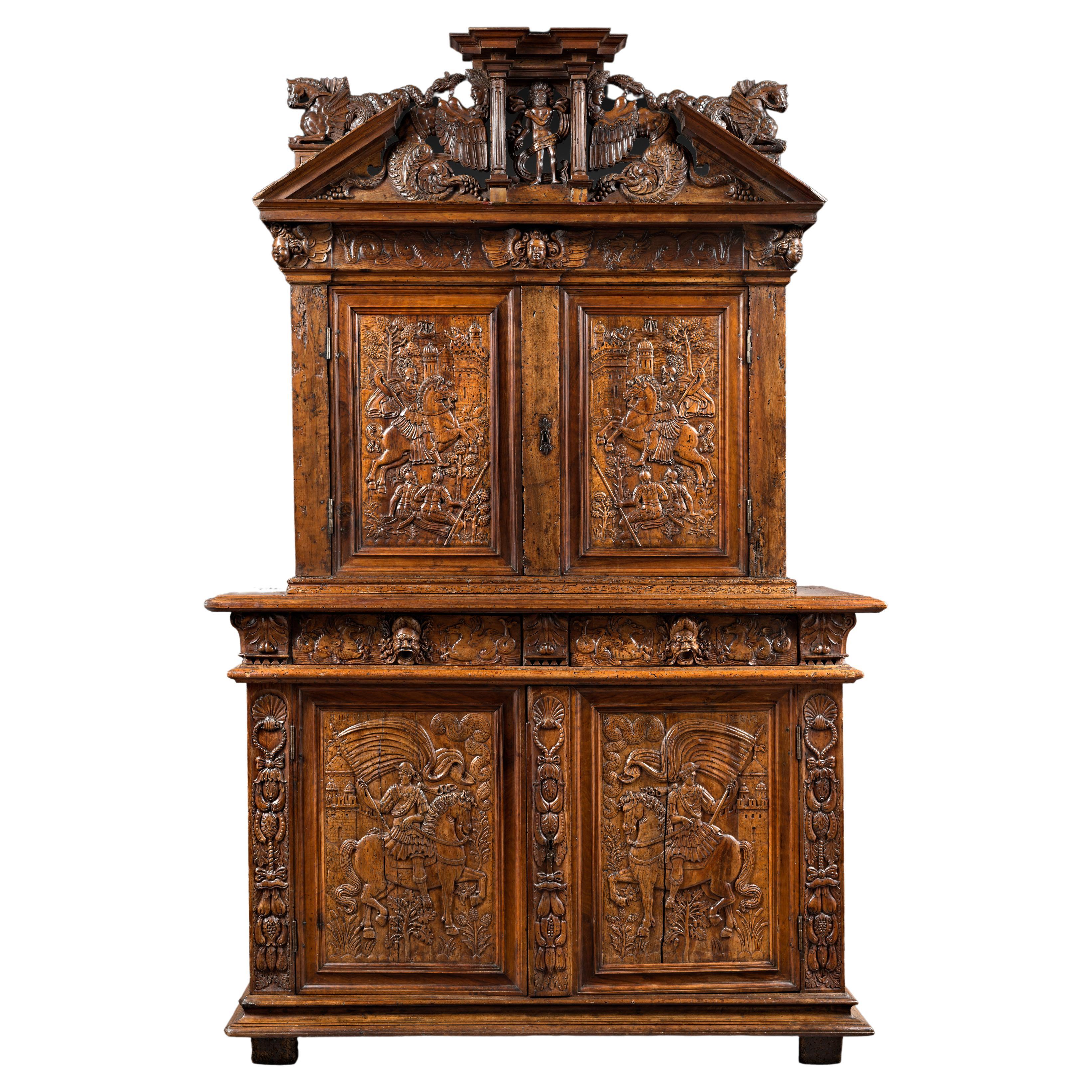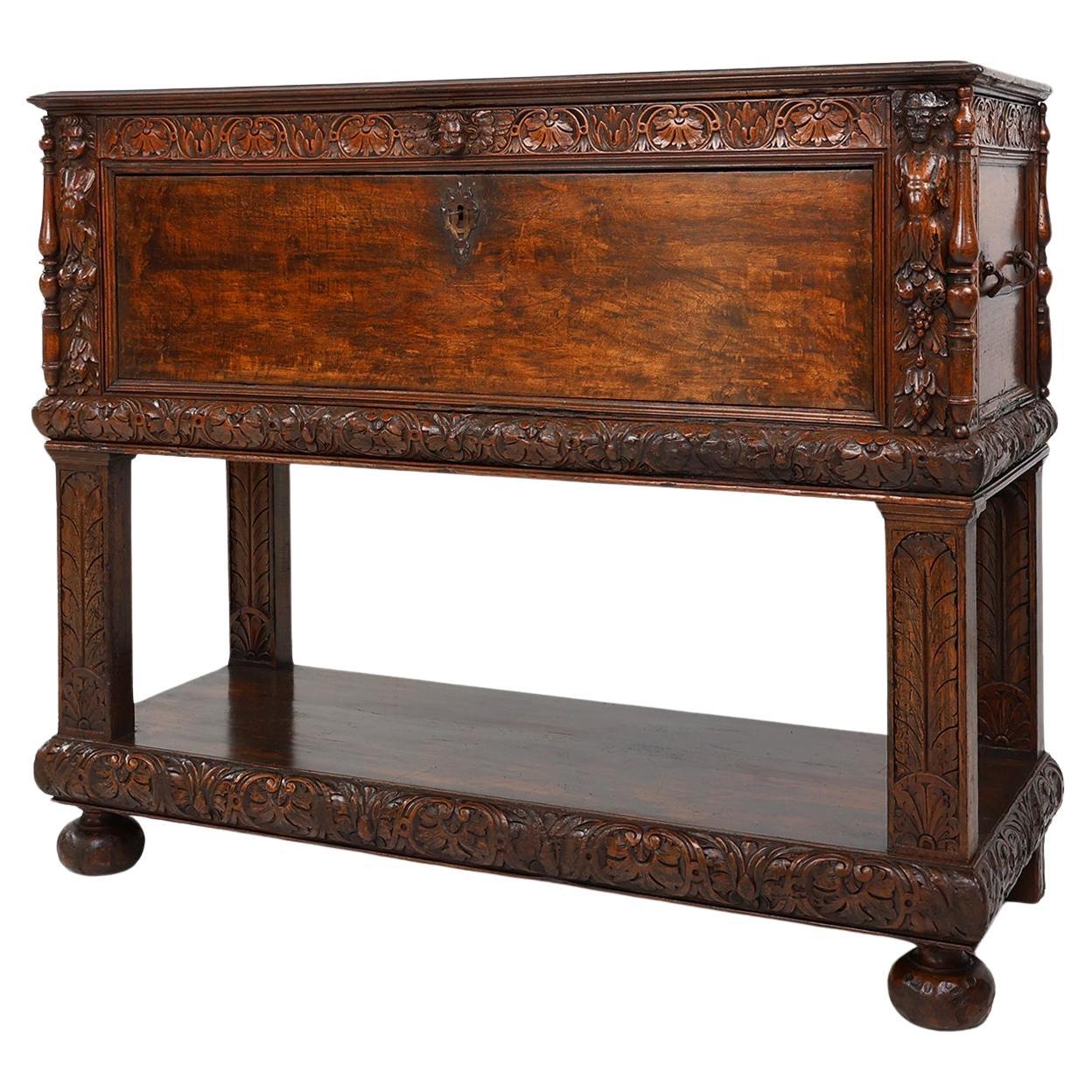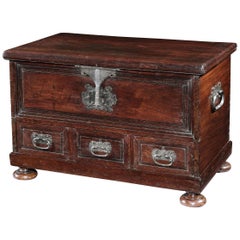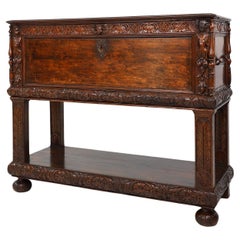Items Similar to Cassone Venetian 16thc Renaissance Cedar Original Stand Neptune Armorial Unicorn
Want more images or videos?
Request additional images or videos from the seller
1 of 21
Cassone Venetian 16thc Renaissance Cedar Original Stand Neptune Armorial Unicorn
$34,245.10
£25,000
€29,460.93
CA$47,054.66
A$52,663.01
CHF 27,486.04
MX$642,217.26
NOK 351,783.96
SEK 333,008.57
DKK 219,862.98
Shipping
Retrieving quote...The 1stDibs Promise:
Authenticity Guarantee,
Money-Back Guarantee,
24-Hour Cancellation
About the Item
A large, museum-quality, late-16th century, cedar, Venetian, cassone on its original stand ; the sea creature ornament probably drawn from De la Cosmographie Universelle, livre III, engraving 1550-1568
• This is the only, known, cassone of this type retaining its original stand.
• The collection in Italy that it originally came from was a palazzo that it had reputedly been in for generations of the same family and this most likely why the stand has survived.
• The decoration is very unusual, and delightful in the array of sea creatures depicted. The connection of the region with the sea is very strong.
• The inner lid is very practical and can be used for display or serving. The interior offers masses of storage space which is particularly suitable for textiles being cedar which repels moths.
• The cassone is a beautiful, rich colour and has developed a lustrous patina.
• The cassone is Illustrated & discussed in discussed in ‘Woods in British Furniture Making’, (Bowett) c13
Provenance: Private collection, Mayorca. Private collection, Italy
Related to: Cassone in V&A collection, no 4886-1858
Width 177 cm., 70 in., Height 87 cm., 34 ½ in. Depth 68 cm. 26 ½ in.
With lid open 155 cm., 61 in
“Late 16th and 17th century, London inventories confirm that cypress wood chests were relatively common in prosperous households. In 1598 there was a cypress chest in the hall of John Mason, a vintner, valued at 50 shillings. It was the most expensive piece of furniture in the house. Similarly there was a ‘fair cypress chest’ in the great chamber of Adrian Moore, haberdasher, in 1618, and a cypress chest worth £ 9 in the hall of Thomas Willis, a clotherworker in 1630. The chests were sometimes described as ‘great’ or ‘small’ but not otherwise described – presumably they were familiar to the compilers of the inventories. They were placed in halls, chambers and parlours, places where they would have been on prominent view. It is noteworthy that only the chests were imported and not, apparently, the wood. “ (p282, Cypress, Woods in British Furniture making)
The decoration is very unusual, and delightful in the array of sea creatures depicted. The connection of the region with the sea is very strong. I have never seen one of these chests on its original stand. The collection in Italy that it came from was a palazzo that it had reputedly been in for generations of the same family and this most likely why the stand has survived. In practical terms, the stand makes the chest a comfortable height to use. The exterior of the chest is a beautiful, mellow colour and has developed a lustrous patina.
The top comprises three planks faced with a shallow, cleated, moulded edge nailed on. The front retains its original hasp and lockplate and, as is commonly found, the lock has been removed but, unusually the original ring hinges have survived. The top opens to reveal an inner lid with ring hinges and a brass ring, revealing a large open storage compartment below, the bottom lined with an old fabric. The underside of the lid retains its original penwork and pierced decoration. The central panel depicts sea creatures, sharks, flatfish, monster fish, sea horses, Neptune and mermaids, probably drawn from De la Cosmographie Universelle, livre III, engraving 1550-1568. The panels either side depicting a crown, the sun and unicorns amongst stylised floral sprays. The surrounding naive penwork border features repeats of three naked ladies in the sea, a man wearing an animal mask with two dogs in a forest and a huntsman with two dogs. The floor of the inside of the cassone is upholstered in an 18th century red and yellow striped woven textile the colours of the Catalan flag. The front is decorated with pierced, silhouettes of beasts, trees and figures. The sides are plain with iron carrying handles. On its original stand, with similar decoration, and bearing a cartouche which would have been decorated with the arms of its original owner. Italian, last quarter of the 16th century.
Condition Report : Old repair to bottom left moulding of top. Some hairline cracks to top. The hasp, lockplate and ring hinges are original, the lock has been removed. Handles probably 18th century. The inner lid was probably added in the 18th century and supporting mechanism in the 19th century. Exceptional original, lustrous colour and patina.
Measures: Width 177 cm. 70 in., height 87 cm. 34 ½ in., depth 68 cm. 26 ½ in.
The cassone was the principal piece of furniture in 16th century, Italy. These chests were made as bridal gifts for nobles and aristocrats from cedar specifically for storing their much prized and valued hangings, clothing and linens, as the wood repels moths and the sweet fragrance delicately scents fabrics. Consquently the cassone, as in this example might be decorated with the family coat of arms or with depictions of virtue and edifying episodes from the Bible. A young woman could not be allowed to enter marriage without some instruction. Later, many cassoni were taken apart so that the decorated front panel could be hung as a painting. The stand of this cassone has a cartouche that would have contained a painted coat of arms in the centre which shows that it was conceived for a noble family. Such cypress or cedar chests, incised in bas relief and pyrographically engraved, have long been associated with Venice and typically have a naïve decoration on the exterior.
Literature:
The 'cypress chests' containing 'arras, counterpoints, costely apparel, tents, and canopies, fine linen, Turkey cushions ... pewter and brass, and all things that belong to house of house-keeping' are mentioned in Shakespeare's Taming of the Shrew. One such cypress chest, filled with bed-hangings, was listed in the 1626 Inventory of Cockesden (P. Thornton, 'Two problems', Furniture History, 1971, p. 68).
Peter Thornton, Cassoni, Forzieri, Goffani and Cassette: Terminology and its problems, in Apollo vol. CXX (1984), no.272 pp.246-251, fig. 16."Cassa 'alla veneziana' (?) ... Since there is reason to believe these cypresswood chests also came from Venice it could well be that they were sometimes described in Italian inventories as 'alla veneziana'.
A group of related chests, surviving in English churches, are discussed by Charles Tracy, Continental Church Furniture in England, Woodbridge, 2001, pp. 142-157.
- Dimensions:Height: 34.26 in (87 cm)Width: 69.69 in (177 cm)Depth: 26.78 in (68 cm)
- Style:Renaissance (Of the Period)
- Materials and Techniques:
- Place of Origin:
- Period:
- Date of Manufacture:1575-1600
- Condition:Repaired: Old repair to bottom left moulding of top. Some hairline cracks to top. The hasp, lockplate and ring hinges are original, the lock has been removed. Handles probably 18th century. The inner lid was probably added in the 18th century. Wear consistent with age and use.
- Seller Location:BUNGAY, GB
- Reference Number:1stDibs: LU3867329525382
About the Seller
5.0
Vetted Professional Seller
Every seller passes strict standards for authenticity and reliability
Established in 1985
1stDibs seller since 2018
97 sales on 1stDibs
Typical response time: 7 hours
- ShippingRetrieving quote...Shipping from: BUNGAY, United Kingdom
- Return Policy
Authenticity Guarantee
In the unlikely event there’s an issue with an item’s authenticity, contact us within 1 year for a full refund. DetailsMoney-Back Guarantee
If your item is not as described, is damaged in transit, or does not arrive, contact us within 7 days for a full refund. Details24-Hour Cancellation
You have a 24-hour grace period in which to reconsider your purchase, with no questions asked.Vetted Professional Sellers
Our world-class sellers must adhere to strict standards for service and quality, maintaining the integrity of our listings.Price-Match Guarantee
If you find that a seller listed the same item for a lower price elsewhere, we’ll match it.Trusted Global Delivery
Our best-in-class carrier network provides specialized shipping options worldwide, including custom delivery.More From This Seller
View AllCassettone or Bureau-Chest, Late 16th Century, Italian Renaissance, Walnut
Located in BUNGAY, SUFFOLK
Exceptional museum quality, Italian, renaissance walnut cassettone with fitted bureau in the upper part & exceptional Bambocci carving, Lombardy.
This magnificent cassettone exudes the character and quality of the finest, late-Renaissance furniture. Late 16th century, Northern Italian furniture often had the sides, legs or angles, 'a Bambocci', incorporating carved figures which were unique sculptures in their own right. The putti on this cassettone are beautifully carved and of sculptural quality. Each angel has one arm raised to heaven, a poignant touch. Showing customary signs of wear from time, the lion’s paw feet make a great statement. This cassettone was conceived to have visual impact through the quality of the carving, as well as being very practical with the writing compartment fitted in the top part. It has survived in very original condition with a few small repairs and losses, and the color and patina are warm and lustrous. This cassettone was illustrated in one of the seminal works on Lombardy furniture in the 1969 and has been in two renowned collections.
The hinged top in two sections faced with a solid moulded edge. The front part has a fall front and opens to reveal a writing compartment. The fall front retains its original lock and is concealed with a false drawer which is above three drawers. All with moulded panels, escutcheons and retaining the original iron handles. The front ends have exceptional, bambocci, carved putti raising their arms to heaven above trailing foliage. Standing on magnificent lion...
Category
Antique 16th Century Italian Baroque Furniture
Materials
Walnut
Cassettone Bureau-Chest Bambocci 16century Italian Renaissance Walnut Lombardy
Located in BUNGAY, SUFFOLK
AN EXCEPTIONAL MUSEUM QUALITY, ITALIAN, RENAISANCE WALNUT CASSETTONE WITH A FITTED BUREAU IN THE UPPER PART & EXCEPTIONAL BAMBOCCI CARVING, LOMBARDY
- This exceptionally rare, museum quality, piece of early furniture was conceived and crafted as an artwork of the finest quality of its time. Throughout time it has been a luxurious, statement piece which has protected it, and fortunately it has survived in virtually, original condition.
- This magnificent cassettone exudes the character and quality of the finest, late-Renaissance furniture.
Northern Italian Renaissance furniture often had the sides, legs or angles, 'a Bambocci', incorporating carved figures which were considered unique sculptures in their own right.
- The putti on this cassettone are beautifully carved and of sculptural quality. Each angel has one arm raised to heaven, a poignant touch.
- The lion’s paw feet are a classical feature and make a great statement.
- This cassettone was conceived to have visual impact through the quality of the carving, as well as being very practical with the writing compartment fitted in the top part.
- It has survived in very original condition with a few small repairs and losses, and the colour and patina are warm and lustrous.
- This cassettone is illustrated Illustrated in C. Alberici, Il Mobile Lombardo, Milan, 1969, p. 45, one of the seminal works on Lombardy furniture, and has been in two renowned collections.
The hinged top in two sections faced with a solid moulded edge. The front part has a fall front and opens to reveal a writing compartment. The fall front retains its original lock and is concealed with a false drawer which is above three drawers. All with moulded panels, escutcheons and retaining the original iron handles. The front ends have exceptional, bambocci, carved putti raising their arms to heaven above trailing foliage. Standing on magnificent lion's-head carved feet. The sides are panelled. Exceptional original colour and patina.
Literature : Illustrated in C. Alberici, Il Mobile Lombardo, Milan, 1969, p. 45. A Gonzalez-Palacois, Il mobile in Liguria, Genova, 1996 illustrates related pieces
Measures: Length 147 ½ cm. 58 in, height 104 cm. 41 in, depth 75 cm. 29½ in,
Provenance: Coll. Private Azzate The Collection of Sandro and Lidia Orsi, Ca’ Mera, Varese. Regarded as one of the most beautiful homes in Lombardy, Ca’ Mera, the country house of Sandro and Lidia Orsi was filled with beautiful objects from many different epochs. A renowned antiquarian from Milan, over his lifetime Sandro and his wife Lidia revived the Renaissance and Baroque character of the house and instilled their own unique vision into the interiors, which culminated with the creation of a Kunst – or Wunderkammer. “I have never seen such an example of poetical taste”, Sir John Pope...
Category
Antique 16th Century Italian Renaissance Commodes and Chests of Drawers
Materials
Walnut
Cassone Marriage Chest Italian Marquetry Coat of Arms Gilded Renaissance L73.5"
Located in BUNGAY, SUFFOLK
A late-16th Century, Museum Quality, Italian Walnut & Fruitwood Marquetry Marriage Chest with a Coat of Arms & Retaining Traces of the Original Gilded Decoration
- Exceptionally rar...
Category
Antique 16th Century Italian Renaissance Blanket Chests
Materials
Fruitwood, Walnut
Chest, Cassone, 17th Century, Portuguese, Baroque, Brazil, Hardwood
Located in BUNGAY, SUFFOLK
This striking chest is made from a Brazilian hardwood which I have not been able to identify. The color and figuring of the timber together with the Classic form and ornamentation su...
Category
Antique Late 17th Century Portuguese Baroque Blanket Chests
Materials
Hardwood
Cassone, 17th Century, Italian, Baroque, Vernacular, Walnut, Carved, Hearts
Located in BUNGAY, SUFFOLK
This handsome cassone has ornament with romantic associations and was most likely a marriage chest. It is a good example of the Italian vernacular, simple in a sophisticated manner. ...
Category
Antique Late 17th Century Italian Baroque Blanket Chests
Materials
Walnut
Chest Small Walnut Spanish Carved Cypress Tree Flowerhead 31" long 16 1/4" high
Located in BUNGAY, SUFFOLK
Museum Quality, Small, Spanish, Walnut Chest With Rare Cypress Tree Carving, A Single Plank Top & Outstanding Colour & Patina
- Rare carved decoration of cypress trees alongside more traditional Spanish ornamentation
- Rare small size
- Exceptional quality and condition
- Exudes the charm and character of Spanish furniture
The single plank top with deep, crisply carved moulding below. The front with two panels, each carved with a large flowerhead roundel with carved cypress trees interposed. On later trestle base. The escutcheon and lock removed. Original pin hinges. The interior with original candle box and lid. The back with two large 'X's and the date '1849' painted in black, probably relating to an inventory or acquisition.
Provenance: Private Collection, purchased from William Job Ltd., Pimlico Road...
Category
Antique 1680s Spanish Baroque Cabinets
Materials
Walnut
You May Also Like
16th Century Venetian Renaissance Cedar Wood Cassone
Located in Hoddesdon, GB
A large 16th century Venetian cedar. wood Cassone is an exquisite example of the craftsmanship characteristic of the Italian Renaissance period, featuring beautifully detailed scenes dating to circa 1550-1580.
Made from cedar wood, the chest has a deep, rich patina. Cedar wood was prized during the Renaissance for its durability and resistance to decay, making it an ideal choice for fine furniture intended to last for generations.
In Renaissance Venice, cassoni were a standard part of a bride's dowry among the nobility and wealthy merchant classes. Venice was a thriving trade hub with a population of about 150,000 in the mid-16th century, and the upper classes commissioned these chests .
The decoration of the chest is particularly breathtaking. Its surface features intricate figural panels that depict various scenes, which include historical, mythological, and symbolic representations. Among these are 16th century knights, chariots, mythical beasts, and lions. The designs are expertly silhouetted against a recessed ground, giving a three-dimensional quality that enhances their visual impact.
The use of punch-work, a decorative technique involving the stamping of the wood with a mesh-like pattern, adds texture and depth to the surfaces. This technique is indicative of the meticulous attention to detail for which artisans in Italy were known during this period.
Overall, this Venetian Cassone...
Category
Antique 16th Century Italian Renaissance Cabinets
Materials
Iron
Italian Renaissance Cassone with the Coat of Arms of the Bonfanti Family
Located in Saint-Ouen, FR
This Italian walnut chest called « cassone » is shaped as an antic sarcophagus. The beautiful patina and the plain lid bring to the fore the facade richly ornated with vegetal motifs...
Category
Antique 16th Century Italian Renaissance Blanket Chests
Materials
Walnut
16th Century Cabinet with Knights Carving from Avignon Workshops 'France'
Located in Saint-Ouen, FR
Collection Jean Thuile
Around the mid-sixteenth century French furnishing evolves in its conception and ornamentation. The start of major archi...
Category
Antique 16th Century French Renaissance Cabinets
Materials
Walnut
16th Century Italian Renaissance Cabinet in walnut with rich carvings
Located in Meulebeke, BE
Italy / 16th Century / Cabinet / walnut / Renaissance / Antique
Rare 16th Century Italian Renaissance cabinet in walnut with hand carved decorations of 3 heads and floral patterns f...
Category
Antique 16th Century Italian Renaissance Cabinets
Materials
Walnut
Late 16th Century Venetian Cedar Wood Cassone Nuptial Chest Garden of Eden Theme
Located in Encinitas, CA
Late 16th century Venetian cedar wood cassone wedding chest featuring finely detailed carving in the champleve decorative style on both the front...
Category
Antique 16th Century Italian Baroque Trunks and Luggage
Materials
Iron
$11,600 Sale Price
60% Off
Italian Renaissance Walnut Cassone
Located in Essex, MA
With flat hinged top opening to a open compartment. The curved case carved with a crest and figures and various designs. Bracket feet with trefoil form apro...
Category
Antique Early 1600s Italian Renaissance Blanket Chests
Materials
Walnut
More Ways To Browse
Used Church Furniture
Antique Church Furniture
Museum Display Stand
Antique Hall Cabinet
English Renaissance Furniture
Used Cabinet Bed
Cedar Antique Furniture
Venetian Cabinet
Cased Fish
Antique Yellow Cabinet
London Display Case
Renaissance Wood Panels
Venetian Figures
Museum Display Case
Venetian Fabrics
Unicorn Furniture
Cabinet In Cedar
16th Century Brass
